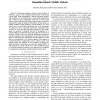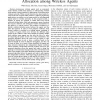82 search results - page 2 / 17 » Control of acyclic formations of mobile autonomous agents |
WSC
2000
15 years 29 days ago
2000
Micro-robots will soon be available for deployment by the thousands. Consequently, controlling and coordinating a force this large to accomplish a prescribed task is of great inte...
88
Voted
IROS
2008
IEEE
15 years 6 months ago
2008
IEEE
— This paper presents a solution to the problem of steering a group of real omnidirectional mobile robots along a given path, while maintaining a desired formation pattern. This ...
AUTOMATICA
2007
2007
Three and higher dimensional autonomous formations: Rigidity, persistence and structural persistence
14 years 11 months ago
In this paper, we generalize the notion of persistence, which has been originally introduced for two-dimensional formations, to Rd for d 3, seeking to provide a theoretical framew...
77
Voted
AAAI
2010
15 years 1 months ago
2010
As a robot formation increases in size or explores places where it is difficult for a human operator to interact, autonomous control becomes critical. We propose a distributed aut...
147
Voted
CORR
2010
Springer
14 years 10 months ago
2010
Springer
—Autonomous wireless agents such as unmanned aerial vehicles, mobile base stations, or self-operating wireless nodes present a great potential for deployment in next-generation w...



